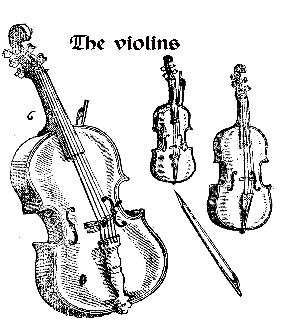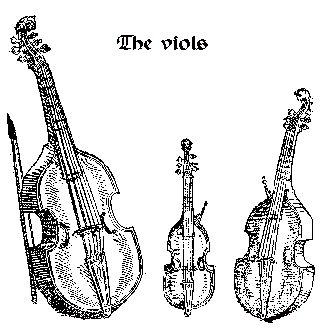 |
Violins and Viols |
|
Let's begin by killing a myth. The viol is not the ancestor of the violin. They are two completely different instruments, with different playing techniques and tone qualities, and were used for different purposes. The viol was invented, or probably developed from earlier instruments, in Italy around 1510. The violin was invented, in the same area, as a new idea around 1530. They lived happily, side by side, for 200 years. From the very beginning, both viols and violins were made in several sizes, to facilitate consort playing (see The Tudor Revolution). The main differences between the two instruments are as follows: The sides (ribs) of the viol are much deeper than the violin, producing a bigger body, and therefore a larger resonance chamber. The general construction of the viol is lighter than the violin, using thinner wood, which again increases resonance. The viol normally has six strings, the violin four. Like most renaissance plucked string instruments, the viol has tied-on frets. The violin has no frets. This requires more precision from the player, but facilitates swift key changes. The viols, including the treble, are played vertically, with the body resting on or between the knees of a seated player. The smaller members of the violin family were originally played resting on the left arm, and later tucked under the chin, as with the modern violin and viola. The violin bow is held with the hand above the bow. The viol bow is held with the hand beneath the bow, and part of the hand normally presses on the hair, allowing variations in hair tension. 
The viol has a rich, dark tone, but with sufficient bite to provide clarity on a melody. A consort of viols produces a thick, complex texture of interweaving melodies that seems to enfold both listeners and players, and provides a hugely satisfying experience for the players in particular. It was considered a polite instrument, suitable for the withdrawing room or the church, and was the "proper" instrument for a lady or a gentleman to play with friends after dinner. The viol was the ultimate consort instrument, ideally suited to the rich, lugubrious music, full of the pangs of unrequited love, so beloved of the Elizabethan English. Only the bass was commonly used as a solo instrument, and even then, its essential character was maintained. The French solo suites of Marin Marais and Saint Colombe, written in a Baroque style for a much modified viol eighty years after Elizabeth's death, still retain the dark, introverted qualities which were always a feature of viol consort playing. The violin, on the other hand, had a much brighter and clearer tone, and was considered a musician's instrument. Many of the dilettanti disliked it, regarding it as brash and clownish. Compared with the richness of the viols, it was. It was the sort of instrument you paid professionals to play, either a solo virtuoso who could amaze you and your guests with his prowess, or a whole bunch of them to provide a grand band for dancing and entertainments. Henry VIII employed a big violin band, consisting of twenty-four violins of different sizes, which became famous throughout Europe. Louis XIV copied the idea over a hundred years later, with his "vingt-quatre violons du roy". The violins quickly became the mainstay of professional bands, particularly when opera really got going in the late sixteenth and early seventeenth centuries. They were now increasingly used by professional musicians employed by the Church. The new continuo style required a solid bass, and initially the bass viol and curtal were commonly pressed into this service. By the late seventeenth century, however, the curtal had been "refined" into the bassoon, and the cello had been invented. This was a cross between the old bass violin and tenor violin, and proved a very useful and convenient size, gradually ousting the bass viol from its pre-eminent positions as both continuo bass and as a solo instrument. 
The polarity of attitude between the serious viols and the showy and frivolous violins had begun to break down a little in the early seventeenth century, although it only disappeared with the demise of the viol itself. Possibly the phenomenal success and popularity of opera and opera-influenced musical forms among the nobility raised the respectability of the violin a little, and a few adventurous gentlemen took it up. Violins were occasionally used as a substitute for treble viols in consorts, and then there developed a fashion for complete violin consorts, as an alternative to the viol consort. The most famous collection of viol consort music, Dowland's "Lachrymae", published in 1604, is specified for "viols or violons". It was only a fashion in England, though. Viol consorts were still being written in England after the Civil War, and the textures were becoming ever thicker. There is already a lute part in "Lachrymae", as well as parts for five viols. Later German consorts used five viols and a chamber organ, which must be about the densest sound ever heard. The viols finally died out in the latter part of the seventeenth century, not because of a takeover by the violins, but because of a change in social practices. The gentry now attended the opera, public concerts or balls in the evenings, and the old play-it-yourself attitude waned. A gentleman who still clung to the renaissance ideal of the all-round achiever would now play flute in a trio sonata, with his mate Alf on violin, and his daughter, or perhaps his intended bride, on the harpsichord. The coninuo would be completed by Aunt Mabel on the cello, and anyone else present would be the audience. The idea of getting everyone who could play or sing to contribute communally had gone. As for the violins, the cello gradually assumed the functions of both tenor and bass, and the bass violin disappeared, to be replaced by the even bigger and deeper double bass, which could really kick out the low notes. Enter Mozart, and we're into modern music, which is where this website stops. |
 Diabolus Homepage |
 Look up another Instrument |
 Email for Diabolus |